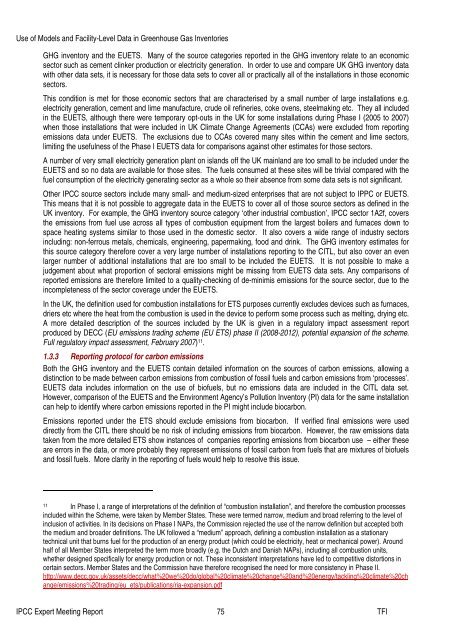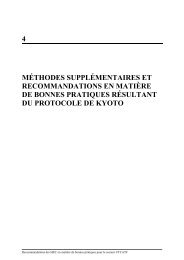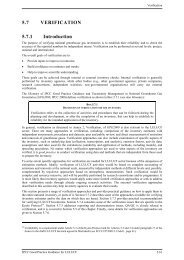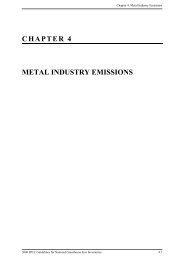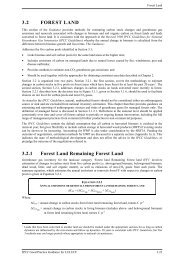Use of Models and Facility-Level Data in Greenhouse Gas Inventories
Use of Models and Facility-Level Data in Greenhouse Gas Inventories
Use of Models and Facility-Level Data in Greenhouse Gas Inventories
You also want an ePaper? Increase the reach of your titles
YUMPU automatically turns print PDFs into web optimized ePapers that Google loves.
<strong>Use</strong> <strong>of</strong> <strong>Models</strong> <strong>and</strong> <strong>Facility</strong>-<strong>Level</strong> <strong>Data</strong> <strong>in</strong> <strong>Greenhouse</strong> <strong>Gas</strong> <strong>Inventories</strong><br />
GHG <strong>in</strong>ventory <strong>and</strong> the EUETS. Many <strong>of</strong> the source categories reported <strong>in</strong> the GHG <strong>in</strong>ventory relate to an economic<br />
sector such as cement cl<strong>in</strong>ker production or electricity generation. In order to use <strong>and</strong> compare UK GHG <strong>in</strong>ventory data<br />
with other data sets, it is necessary for those data sets to cover all or practically all <strong>of</strong> the <strong>in</strong>stallations <strong>in</strong> those economic<br />
sectors.<br />
This condition is met for those economic sectors that are characterised by a small number <strong>of</strong> large <strong>in</strong>stallations e.g.<br />
electricity generation, cement <strong>and</strong> lime manufacture, crude oil ref<strong>in</strong>eries, coke ovens, steelmak<strong>in</strong>g etc. They all <strong>in</strong>cluded<br />
<strong>in</strong> the EUETS, although there were temporary opt-outs <strong>in</strong> the UK for some <strong>in</strong>stallations dur<strong>in</strong>g Phase I (2005 to 2007)<br />
when those <strong>in</strong>stallations that were <strong>in</strong>cluded <strong>in</strong> UK Climate Change Agreements (CCAs) were excluded from report<strong>in</strong>g<br />
emissions data under EUETS. The exclusions due to CCAs covered many sites with<strong>in</strong> the cement <strong>and</strong> lime sectors,<br />
limit<strong>in</strong>g the usefulness <strong>of</strong> the Phase I EUETS data for comparisons aga<strong>in</strong>st other estimates for those sectors.<br />
A number <strong>of</strong> very small electricity generation plant on isl<strong>and</strong>s <strong>of</strong>f the UK ma<strong>in</strong>l<strong>and</strong> are too small to be <strong>in</strong>cluded under the<br />
EUETS <strong>and</strong> so no data are available for those sites. The fuels consumed at these sites will be trivial compared with the<br />
fuel consumption <strong>of</strong> the electricity generat<strong>in</strong>g sector as a whole so their absence from some data sets is not significant.<br />
Other IPCC source sectors <strong>in</strong>clude many small- <strong>and</strong> medium-sized enterprises that are not subject to IPPC or EUETS.<br />
This means that it is not possible to aggregate data <strong>in</strong> the EUETS to cover all <strong>of</strong> those source sectors as def<strong>in</strong>ed <strong>in</strong> the<br />
UK <strong>in</strong>ventory. For example, the GHG <strong>in</strong>ventory source category ‘other <strong>in</strong>dustrial combustion’, IPCC sector 1A2f, covers<br />
the emissions from fuel use across all types <strong>of</strong> combustion equipment from the largest boilers <strong>and</strong> furnaces down to<br />
space heat<strong>in</strong>g systems similar to those used <strong>in</strong> the domestic sector. It also covers a wide range <strong>of</strong> <strong>in</strong>dustry sectors<br />
<strong>in</strong>clud<strong>in</strong>g: non-ferrous metals, chemicals, eng<strong>in</strong>eer<strong>in</strong>g, papermak<strong>in</strong>g, food <strong>and</strong> dr<strong>in</strong>k. The GHG <strong>in</strong>ventory estimates for<br />
this source category therefore cover a very large number <strong>of</strong> <strong>in</strong>stallations report<strong>in</strong>g to the CITL, but also cover an even<br />
larger number <strong>of</strong> additional <strong>in</strong>stallations that are too small to be <strong>in</strong>cluded the EUETS. It is not possible to make a<br />
judgement about what proportion <strong>of</strong> sectoral emissions might be miss<strong>in</strong>g from EUETS data sets. Any comparisons <strong>of</strong><br />
reported emissions are therefore limited to a quality-check<strong>in</strong>g <strong>of</strong> de-m<strong>in</strong>imis emissions for the source sector, due to the<br />
<strong>in</strong>completeness <strong>of</strong> the sector coverage under the EUETS.<br />
In the UK, the def<strong>in</strong>ition used for combustion <strong>in</strong>stallations for ETS purposes currently excludes devices such as furnaces,<br />
driers etc where the heat from the combustion is used <strong>in</strong> the device to perform some process such as melt<strong>in</strong>g, dry<strong>in</strong>g etc.<br />
A more detailed description <strong>of</strong> the sources <strong>in</strong>cluded by the UK is given <strong>in</strong> a regulatory impact assessment report<br />
produced by DECC (EU emissions trad<strong>in</strong>g scheme (EU ETS) phase II (2008-2012), potential expansion <strong>of</strong> the scheme.<br />
Full regulatory impact assessment, February 2007) 11 .<br />
1.3.3 Report<strong>in</strong>g protocol for carbon emissions<br />
Both the GHG <strong>in</strong>ventory <strong>and</strong> the EUETS conta<strong>in</strong> detailed <strong>in</strong>formation on the sources <strong>of</strong> carbon emissions, allow<strong>in</strong>g a<br />
dist<strong>in</strong>ction to be made between carbon emissions from combustion <strong>of</strong> fossil fuels <strong>and</strong> carbon emissions from ‘processes’.<br />
EUETS data <strong>in</strong>cludes <strong>in</strong>formation on the use <strong>of</strong> bi<strong>of</strong>uels, but no emissions data are <strong>in</strong>cluded <strong>in</strong> the CITL data set.<br />
However, comparison <strong>of</strong> the EUETS <strong>and</strong> the Environment Agency’s Pollution Inventory (PI) data for the same <strong>in</strong>stallation<br />
can help to identify where carbon emissions reported <strong>in</strong> the PI might <strong>in</strong>clude biocarbon.<br />
Emissions reported under the ETS should exclude emissions from biocarbon. If verified f<strong>in</strong>al emissions were used<br />
directly from the CITL there should be no risk <strong>of</strong> <strong>in</strong>clud<strong>in</strong>g emissions from biocarbon. However, the raw emissions data<br />
taken from the more detailed ETS show <strong>in</strong>stances <strong>of</strong> companies report<strong>in</strong>g emissions from biocarbon use – either these<br />
are errors <strong>in</strong> the data, or more probably they represent emissions <strong>of</strong> fossil carbon from fuels that are mixtures <strong>of</strong> bi<strong>of</strong>uels<br />
<strong>and</strong> fossil fuels. More clarity <strong>in</strong> the report<strong>in</strong>g <strong>of</strong> fuels would help to resolve this issue.<br />
11 In Phase I, a range <strong>of</strong> <strong>in</strong>terpretations <strong>of</strong> the def<strong>in</strong>ition <strong>of</strong> “combustion <strong>in</strong>stallation”, <strong>and</strong> therefore the combustion processes<br />
<strong>in</strong>cluded with<strong>in</strong> the Scheme, were taken by Member States. These were termed narrow, medium <strong>and</strong> broad referr<strong>in</strong>g to the level <strong>of</strong><br />
<strong>in</strong>clusion <strong>of</strong> activities. In its decisions on Phase I NAPs, the Commission rejected the use <strong>of</strong> the narrow def<strong>in</strong>ition but accepted both<br />
the medium <strong>and</strong> broader def<strong>in</strong>itions. The UK followed a “medium” approach, def<strong>in</strong><strong>in</strong>g a combustion <strong>in</strong>stallation as a stationary<br />
technical unit that burns fuel for the production <strong>of</strong> an energy product (which could be electricity, heat or mechanical power). Around<br />
half <strong>of</strong> all Member States <strong>in</strong>terpreted the term more broadly (e.g. the Dutch <strong>and</strong> Danish NAPs), <strong>in</strong>clud<strong>in</strong>g all combustion units,<br />
whether designed specifically for energy production or not. These <strong>in</strong>consistent <strong>in</strong>terpretations have led to competitive distortions <strong>in</strong><br />
certa<strong>in</strong> sectors. Member States <strong>and</strong> the Commission have therefore recognised the need for more consistency <strong>in</strong> Phase II.<br />
http://www.decc.gov.uk/assets/decc/what%20we%20do/global%20climate%20change%20<strong>and</strong>%20energy/tackl<strong>in</strong>g%20climate%20ch<br />
ange/emissions%20trad<strong>in</strong>g/eu_ets/publications/ria-expansion.pdf<br />
IPCC Expert Meet<strong>in</strong>g Report 75 TFI


